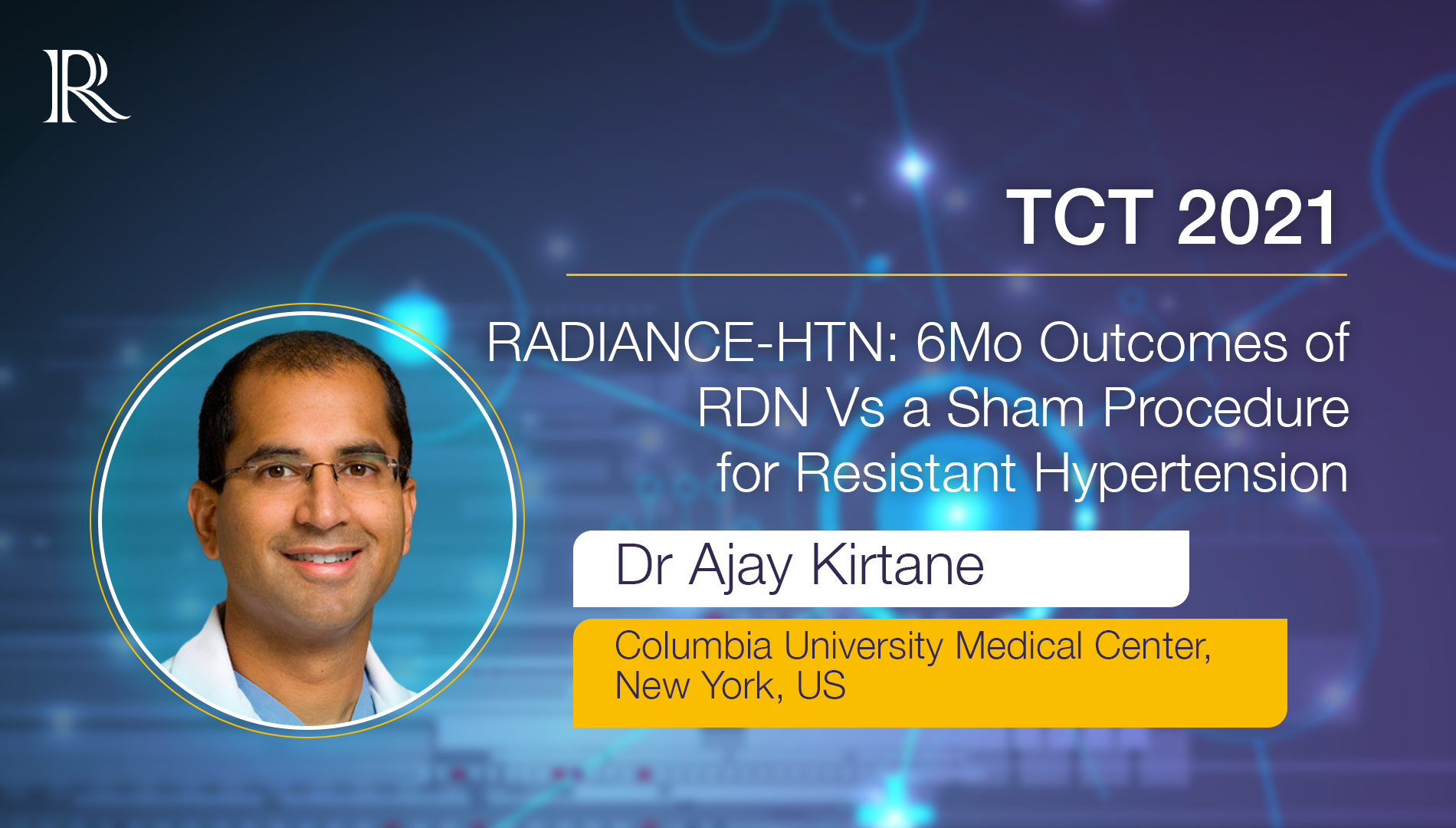TCT 2021: Late-breaking Science Video Collection
Published: 09 November 2021
-
Views:
 2343
2343
-
Likes:
 7
7
-
Views:
 2343
2343
-
Likes:
 7
7
-
 Up Next
Up Next -
 4m 44s
4m 44s -
 4m 28sPart 2 | Session 10 BIO-RESORT: 5Y Outcomes
4m 28sPart 2 | Session 10 BIO-RESORT: 5Y Outcomes -
 10m 19sPart 2 | Session 11 OPTIMUM Registry: PCI in Patients at Prohibitive Risk for CABG
10m 19sPart 2 | Session 11 OPTIMUM Registry: PCI in Patients at Prohibitive Risk for CABG
-
 22m 43sPart 1 | Session 1 What's Hot at TCT 2021: View from the Thoraxcenter Nicolas M Van Mieghem, Joost Daemen
22m 43sPart 1 | Session 1 What's Hot at TCT 2021: View from the Thoraxcenter Nicolas M Van Mieghem, Joost Daemen
-
 22m 33sPart 1 | Session 2 View from the Thoraxcenter: TCT 21 Late-breaking Science Wrap Up Nicolas M Van Mieghem, Joost Daemen
22m 33sPart 1 | Session 2 View from the Thoraxcenter: TCT 21 Late-breaking Science Wrap Up Nicolas M Van Mieghem, Joost Daemen
-
 10m 32sPart 2 | Session 1 FAME3: PCI Guided by FFR Didn't Meet Noninferiority for 1Y Outcomes Compared to CABG William Fearon
10m 32sPart 2 | Session 1 FAME3: PCI Guided by FFR Didn't Meet Noninferiority for 1Y Outcomes Compared to CABG William Fearon
-
 4m 40sPart 2 | Session 2 iFR-SWEDEHEART: No Difference in Outcome at 5-yrs of iFR vs FFR Matthias Gotberg
4m 40sPart 2 | Session 2 iFR-SWEDEHEART: No Difference in Outcome at 5-yrs of iFR vs FFR Matthias Gotberg
-
 8m 19sPart 2 | Session 3 SUGAR: Amphilimus-eluting Stents VS Zotarolimus-eluting Stents in Patients With DB Rafael Romaguera
8m 19sPart 2 | Session 3 SUGAR: Amphilimus-eluting Stents VS Zotarolimus-eluting Stents in Patients With DB Rafael Romaguera
-
 7m 32sPart 2 | Session 4 CHOICE-CLOSURE: Plug-based Vs Suture-based Large-bore Vascular Closure Mohamed Abdel-Wahab
7m 32sPart 2 | Session 4 CHOICE-CLOSURE: Plug-based Vs Suture-based Large-bore Vascular Closure Mohamed Abdel-Wahab
-
 7m 27sPart 2 | Session 5 TRISCEND II: 6Mo Outcomes Show TR Reduction in Majority of Patients Susheel Kodali
7m 27sPart 2 | Session 5 TRISCEND II: 6Mo Outcomes Show TR Reduction in Majority of Patients Susheel Kodali
-
 8m 8sPart 2 | Session 6 SCB Shows Similar Angiographic Outcomes to Paclitaxel DCB Bruno Scheller
8m 8sPart 2 | Session 6 SCB Shows Similar Angiographic Outcomes to Paclitaxel DCB Bruno Scheller
-
 3m 37sPart 2 | Session 7 Intrepid TMVR: Results Show Improved NYHA Class at 30 Days
3m 37sPart 2 | Session 7 Intrepid TMVR: Results Show Improved NYHA Class at 30 Days
Overview
Our regular review series View from the Thoraxcenter hosted by Prof Nicolas Van Mieghem and Dr Joost Daemen (Thoraxcentre, Erasmus MC, Rotterdam, NL) provide a concise and insightful preview of the late-breaking science presented at TCT 2021.
Short, accessible Expert Interviews will be available conducted with select faculty focusing on the results, applicability, and impact on future research.
More from this programme
Part 1
View from the Thoraxcenter: Preview of the Late-Breaking Trials
Part 2
Expert Interviews
Faculty Biographies

Wan Azman Wan Ahmad
Professor and Senior Consultant Cardiologist
Prof Wan Azman Wan Ahmad is Professor and Senior Consultant Cardiologist at University of Malaya Medical Centre, Kuala Lumpur, Malaysia. He currently serves as President of the National Heart Association of Malaysia.
Transcript
Importance of this study
Paclitaxel-coated balloon is recommended and well-established in the treatment of narrow, or blocked coronary arteries which were previously treated with stents This is called in-stent restenosis. Currently Paclitaxel-coated balloon is gaining acceptance in the new blockage, what we call De Novo coronary disease. However, what is not clear whether there is an alternative drug, a sirolimus drug can be alternative to the Paclitaxel-coated drug. So the advantage of the drug-coated balloon is that we do not leave any foreign implant. So this is a preferred strategy because we avoid inflammatory response to the vessel wall. This is in line with the concept of leaving nothing behind. So we studied the novel sirolimus balloon. This balloon, the drug is about 4 microgram per mm squared, it's crystalline coated and additive is Butylated hydroxy toluene. Yes, persistent vessel concentration of up to 50% of the initial concentration at one month. So we compared this balloon, this balloon with the well-established Paclitaxel coated balloon, the SeQuent® Please NEO 3 microgram per millimetre squared to determine the efficacy and the safety of this balloon.
Study Design and Patient Population
The study, the study coordinator, coordination, the data monitoring and the site monitoring is by InnoRa, Berlin and the study device was given by Braun. There are six sites from Malaysia and we have chosen 70 patients with De Novo lesions were enrolled in this study. 35 patients were assigned to paclitaxel coated balloon and another 35 were assigned to the Sirolimus Coated balloon. There is a clinical follow-up of one month, six months and one year and an angiographic follow-up at six months.
Key Findings
The key finding, main key finding is the late lumen loss at six months. Late lumen loss is the luminal diameter of the artery post-treatment and at six months after the follow-up angiogram. So what we found that in the Sirolimus Coated balloon arm, the late lumen loss is 0.1 millimetre. Standard deviation of 0.32 In the paclitaxel arm, the late lumen loss is 0.01 with a standard deviation of 0.33 mm. So the non inferior imaging should be defined as 0.10 - 3.5 was shown. Another interesting finding that we noted that from this study was the late lumen enlargement. This is what we call positive remodelling. The late lumen enlargement is a phenomenon when we see that the healing of the vessel that takes place and this results in the enlargement of the vessel diameter. This is what we call positive remodelling. So we found this positive remodelling is seen in 58% of the patients in the paclitaxel balloon arm and only about 32% in the Sirolimus coated balloon arm. So p is 0.019 which is statistically significant. So we see that in paclitaxel, a patient treated with paclitaxel, the positive remodelling is much more compared to those patients who receive Sirolimus coated balloon. We were also comparing the clinical events between the two groups, the Sirolimus coated balloon and the paclitaxel balloon. There was no difference in MACE as defined by cardiac death, target lesion revascularization or target vessel myocardial infarction. Also no difference between the two arms.
Impact on Practice
I think it's a very, very important study. As I mentioned earlier, the use of drug coated balloons is in line with the concept of leaving nothing behind. Nowadays in patients with coronary artery disease. The default treatment is by stenting. So as we know that we put a stent, we are caging the artery. So if you're able to do without the stent then we can maintain the normal physiology of the artery. And another advantage that is shown that for any foreign material has a much better long-term outcome in terms of mortality and in terms of stent thrombosis. Also being a potential possibility for the shortening of dual antiplatelet therapy so, without this foreign material inside the vessel wall it leaves options, for patients with coronary artery bypass graft surgery in the future. So, with this finding The use of drug-coated balloons in De Novo coronary arteries Then there will be more people who will be willing or be able to use this, this technology in the treatment of coronary artery disease. And we see in our country, the impact on our country, the paclitaxel coated balloon have increased to 50% in the last, our last NCBD PCI report.
Next Steps
Of course, this study was a small study, 70 patients which was randomised into Sirolimus coated balloon and a paclitaxel coated balloon. So we need a longer followup. And of course we need a confirmatory trial.





